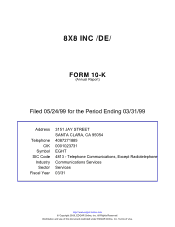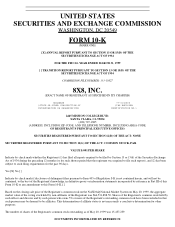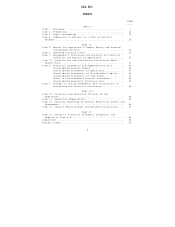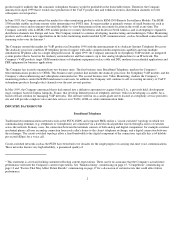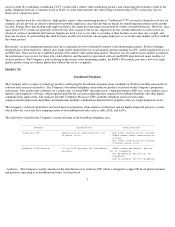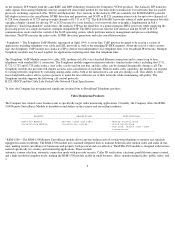8x8 1999 Annual Report Download - page 5
Download and view the complete annual report
Please find page 5 of the 1999 8x8 annual report below. You can navigate through the pages in the report by either clicking on the pages listed below, or by using the keyword search tool below to find specific information within the annual report.
This Report on Form 10-K contains forward-looking statements, including but not limited to those specifically identified as such, that involve
risks and uncertainties. The statements contained in this Report on Form 10-K that are not purely historical are forward-looking statements,
including without limitation statements regarding the Company's expectations, beliefs, intentions or strategies regarding the future. All
forward-looking statements included in this Report on Form 10-K are based on information available to the Company on the date hereof, and
the Company assumes no obligation to update any such forward-looking statements. The Company's actual results could differ materially from
those anticipated in these forward-looking statements as a result of a number of factors, including, but not limited to, those set forth below
under the headings "Manufacturing," "Competition" and "Factors That May Affect Future Results" and elsewhere in this Report on Form 10-
K.
PART I
ITEM 1. BUSINESS
OVERVIEW
8x8, Inc. develops, manufactures and markets telecommunication equipment with an emphasis on multimedia Internet protocol (IP)
applications. The Company's products are highly integrated, leverage its proprietary technology and are comprised of communication
semiconductors, multimedia compression algorithms, network protocols and embedded system design. These products may be used in
applications including voice-over-IP (VoIP), video monitoring and streaming, and videoconferencing. The company markets its products
mainly to original equipment manufacturers (OEMs), but also to end users for its Video Monitoring system products.
The Company began developing its multimedia communication technology in the form of programmable multimedia semiconductors and
accompanying software in 1990, and has subsequently become a leading manufacturer of semiconductors for the embedded videoconferencing
and videophone markets. Customers for the Company's multimedia processors include OEM manufacturers such as Sony Electronics, Inc.,
Samsung, Mitsubishi, Panasonic, Siemens AG and PictureTel Corporation. To date the primary customer applications for the Company's
semiconductors have been multimedia communication terminals (such as videophones, telephones or room conferencing systems) for the
integrated services digital network (ISDN) and the public switched telephone network (PSTN). Recently, however, several of the Company's
customers have announced IP communications capabilities for their products, allowing voice, video and data connections via local area
networks (LANs), wide area networks (WANs), and the Internet. The Company intends to focus all of its future efforts with respect to
development of multimedia communications semiconductors on IP applications.*
In an effort to expand the available market for its multimedia communication products, and to capitalize on its vertically integrated technology,
the Company began developing low cost consumer videophones and marketing these products to consumers under the ViaTV brand name in
1997. The ViaTV videophone enables phone call participants to both hear and see each other while communicating over a standard analog
telephone line (commonly known as a plain old telephone service, or POTS, line). The Company shipped its first ViaTV product in February
1997, and over the next two years introduced several new videophone products, expanded its distribution channels in North America, Europe
and Asia, and became a leading manufacturer of consumer videophones. However, in the fourth quarter of fiscal 1999 the Company determined
that due to a combination of factors including the high cost of maintaining a consumer distribution channel, the slower than expected growth
rate of the consumer videophone market, and the low gross margins typical of a consumer electronics
* This statement is a forward looking statement reflecting current expectations. There can be no assurance that the Company's actual future
performance will meet the Company's current expectations. See "Manufacturing" commencing on page 15, "Competition" commencing on
page 13 and "Factors That May Affect Future Results" commencing on page 17 for a discussion of certain factors that could affect future
performance.
1

